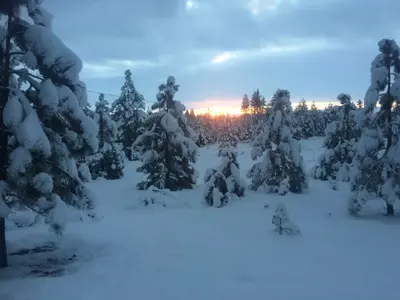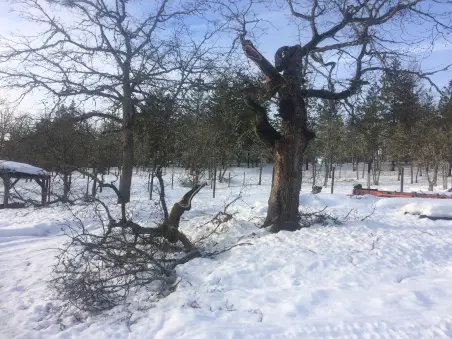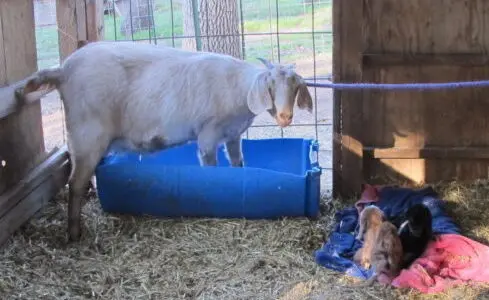Death in a Living Forest
 Herland Forest is different from most other cemeteries. While, yes, it is a place where the dead are laid to rest, it’s also a place where all the natural cycles of life play out. It’s a place where a person can continue to be a part of the living world.
Herland Forest is different from most other cemeteries. While, yes, it is a place where the dead are laid to rest, it’s also a place where all the natural cycles of life play out. It’s a place where a person can continue to be a part of the living world.
For nine months each year, our forest is a celebration of life—and then winter takes over and life sleeps for three months. The forest in winter may look passive, but actually the life process is still in play. As I sit by my wood stove doing end-of-year paperwork, I look out the window at the snow-blanketed forest. It reminds me, “Just remember, in the winter, far beneath the bitter snow, lies the seed that with the sun’s love, in the spring, becomes the rose.” Those words are from The Rose, and here’s my favorite version of the song.

Last winter, we had two six inch snowfalls, and the snow melted between the first and the second snowfalls. This year’s blanket of snow was deep and long lasting—it was more than we’ve seen in the past twenty-six years. While our people and animals all made it through fine, the damp snow did take a toll on the forest. The combination of temps in the mid-twenties (frozen wood is brittle) and a heavy snowfall can put a lot of stress on the trees.

Some trees are especially vulnerable to the ravages of deep winter. The hardest hit were Herland’s elder trees—the ancient oaks that are more than two centuries old. Their deep root systems protect them from the gusty spring winds that can blow down our firs and pines, but for the old oaks, a heavy build up of snow followed by a light rain can snap off entire limbs. Every winter we see some snow damage to our trees, but this past winter was especially hard on our old oaks.

Wood chips are an integral part of our enhanced, natural burial process, but we don’t sacrifice living trees in order to produce the chips. Instead, most of the chips are generated in the spring, as we clean up the damage caused by winter storms. Then, when those wood chips are used to encase a decedent, the biomass becomes an integral part of Herland’s enhanced natural burial process. That enables us to sequester the carbon that would otherwise be released into the atmosphere as carbon dioxide. Moreover, if these dead branches were not removed from the forest floor, these broken limbs would become the fuel that could make a future forest fire so devastating.
But winter can also be a time of new life. When the snow’s deep, our sheep take advantage of the snow and stay close to the hay barn where the coyotes know to not go. Our sheep like to range out and explore, but those early-morning coyote calls trigger a strong desire in the pregnant ewes to give birth in a protected environment.
The indigenous people often referred to the month of February as the “starving moon” because there wasn’t much out there to eat. Each morning we can hear the local coyote pack howling as they hunt for something to eat. In that window of time between first light and dawn, that sound is enough to keep the pregnant ewes hanging out at the hay barn. Once the sun’s up and they can keep a sharp eye out for predators, they’ll venture out to graze the forest, but without enough light to see by, sheep are cautious folk.
 Our goats evolved in Africa, and as a result their bodies are just not designed to handle snow. Instead of allowing them to breed in the early fall, as would be their desire, we keep the does and bucks apart for a couple of months to make sure that they don’t kid before the snow is gone. Losing babies born in a blizzard is heart wrenching. Better to delay, and even then we take steps to coop up mom and baby in a shelter until the birthing process is complete.
Our goats evolved in Africa, and as a result their bodies are just not designed to handle snow. Instead of allowing them to breed in the early fall, as would be their desire, we keep the does and bucks apart for a couple of months to make sure that they don’t kid before the snow is gone. Losing babies born in a blizzard is heart wrenching. Better to delay, and even then we take steps to coop up mom and baby in a shelter until the birthing process is complete.
Our sheep, with their thick wool coats, seem to prefer winter. Their fleeces are so water-proof and insulating that it’s common to see them walking around with a couple of inches of snow on their backs. In winter, the sheep laugh at the shivering goats, and in summer, the goats laugh at the sweltering sheep.
And we do what we can to help both flocks cope.
 Here’s a pic of this year’s first set of lambs. We keep them “jugged” up for their first week because otherwise they’d wear themselves out trying to keep up with their mother. Once they’ve had their colostrum and have gotten the hang of nursing, they’re welcome to head out and start interacting with the rest of the flock.
Here’s a pic of this year’s first set of lambs. We keep them “jugged” up for their first week because otherwise they’d wear themselves out trying to keep up with their mother. Once they’ve had their colostrum and have gotten the hang of nursing, they’re welcome to head out and start interacting with the rest of the flock.
